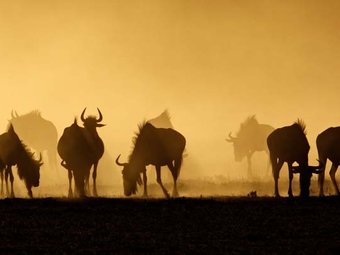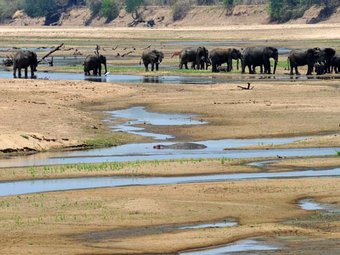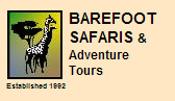Zambia and Botswana
15 days—Zambia and Botswana: Continent of Africa
$10650-11459 USD
pp
Safari summary
Zambia: The real Africa", beckons to the intrepid and to the adventurous. On this ulendo (trip) we will explore the adrenaline raising Victoria Falls, follow in the footsteps of the most famous of explorers, David Livingstone, whose exploration heralded the establishment of missions promoting the spread of Christianity. We will stand in awe at one of man’s greatest feats; Lake Kariba. Then, crossing the mighty Zambezi River, we continue to follow Livingstone’s route as we embark on a journey through a land of mighty contrast, unsurpassed hospitality and unique wildlife, taking in the astounding wildlife and birdlife we will cross into Botswana. Despite its natural bounty with magnificent landscapes trampled by some of Africa’s finest wild herds, Botswana remains all but unvisited by independent travellers. The endless miles of untouched wilderness invite unparalleled and safe adventure.
About this tour
| Tour type | Custom, tailor-made, private | |
| Main focus | Walking safari—with armed guard | |
| Activity level | Moderate activity | |
| Best months | ||
| Countries | ||
| Parks |
Fine details
Safari highlights
- Cultural visits—orphanages, markets, schools
Itinerary
Day 1
Kafue
Day 1: Lusaka to Lake Kariba You are collected from Lusaka Airport and after shopping in Lusaka driven to our lodge at Kariba. We head south, passing the Kafue flats en-route to Siavonga, Lake Kariba. This is also an excellent place to pick up beautiful Tonga baskets and carvings. We visit a local village and a fossil forest en-route. This national monument dates back 150 million years. The afternoon is spent exploring the lakeshore. There is time for option such as canoeing or try your hand at tiger fishing. Tour briefing by safari guide – plus payment of tour cost balance. Lodge, 2 nights (L).
Day 2
Zambezi
Day 2: Lake Kariba Work on the biggest man-made lake of its time started in the 1950’s. It was considered a triumph of mankind and came into existence following the damming of the Zambezi River to provide hydroelectric power to the industries of Zambia and Zimbabwe. The creation of Lake Kariba was not without controversy: the Tonga tribe was uprooted to make way for the dam, not only did they oppose the building, but according to the Tongas, Nyaminyami, the snakelike River God was opposed to the construction. The Batonga believe the wrathful River God sent the biggest storm in 10,000 years that destroyed the cofferdams in 1957. We visit the dam wall, which remains a major attraction. There will be an optional excursion to take a cruise at sundown or cross to the town of Kariba in Zimbabwe.
Day 3
Victoria Falls
Day 3: Victoria Falls Today is a short but interesting ulendo to one of the seven natural wonders of the world; the Victoria Falls. These are the greatest curtain of falling water on earth. The clouds of spray and tremendous roar produced by this immense amount of water crashing down into a narrow chasm, gave rise to its more evocative African Name, Mosi-O-Tunya, “Smoke that Thunders”. About 1,708 metres wide and 103 metres deep at the highest point; the Victoria Falls is in fact divided into six waterfalls: Devils Cataract, Main Falls, Horseshoe Falls, Rainbow Falls, Armchair Falls and Eastern Cataract. For centuries, these dazzling waterfalls were considered to be sacred and local people came here to pray and make their offerings. Only following the visit of David Livingstone on 16th November 1855 did they come to the attention of the western world. Soon they became an integral part of the grand African tour for the adventurous and wealthy. However, only with the explosion of air travel have more people been able to view them. After settling into our lodge we head for a visit to the falls. There can be few experiences on earth as gratifying as watching the gushing white waters of the magnificent Victoria Falls. The experience is enhanced by the fact that it is possible to walk in front of them, unlike many other waterfalls, which are seen from the side. Well-kept paths lead to different points for the views of the falls. But the most astonishing view is from the Knife Edge Bridge. This is as close as you will ever get to the falls. Lodge, 2 nights (B).
Day 4
Victoria Falls | Zambezi
Day 4: Victoria Falls Today is set aside to explore this area. The following optional excursions are available. Canoeing: The natural beauty of the Zambezi is unsurpassed and a canoe trip is the best way to enjoy the upper parts of this lovely river. This is a part of the Zambezi so different from the one that challenges white water rafters. Jet Boating: For stomach-churning thrills, spin on the Zambezi in a sleek and powerful jet boat. River Surfing: If you ever wanted to pit yourself against the Zambezi, river surfing is the way to do it. After learning the basic skills of catching waves in calm water, armed only with a helmet, flippers, wetsuit and body board take on progressively larger rapids with names like Terminator, Gnashing Jaws of Death and Stairway to Heaven Flight of Angels: For an unsurpassed view of the famous water falls and the Zambezi River rapids, just above and below the falls take to the air in a helicopter or light wing aircraft. Or even more exiting take a micro light flight. White-water rafting: White-water rafting is the most famous activity in the area and how it began is a piece of local history. In 1981, amid gales of publicity, Sobek, an American rafting company made the first attempt to raft the Zambezi. This attempt was successful and within a week of this first exploratory expedition, Sobek was offering commercial trips down the Zambezi. Today there are numerous reputable and licensed companies
Day 5
Zambezi
Day 5: Gweta We leave the Vic Falls behind and after an hour cross the Zambezi River by ferry into Botswana. We visit the frontier town of Kasane to change money into the local currency “Pula”. We head south to Nata passing enclaves of teak and mukwa woodland. There is a good chance to spot elephant, giraffe, small mammals and even the odd predator. From Nata we turn west into the Kalahari. The afternoon is spent settling into our accommodation at Gweta. We can further explore this thatched village with towering palm trees, grey sand, vagrant donkeys and horses. Its name is from San and means, “where the big frogs meet”. Gweta offers a rare opportunity to stay in a traditional village and experience life going on around you without feeling like an intruder. Optional is an excursion to visit the Magadikgadi Pans. At 12,000 square kilometres its sheer extent makes an impression. The expansiveness, silence and total isolation are awesome. Lodge, 12 nights (B).
Day 6
Day 6: D’Kar After breakfast we head further west, travelling through the Magadikgadi Pans Game Reserve to Maun. From Maun we head south past Lake Ngami to the San Farm at D’Kar. We settle into our comfortable accommodation, which is a farmhouse. The Dqãe Qare Game Farm is owned by the Ncoakhoe bushman people (San) of D’Kar. The aim of the project is to create employment, preserve the San culture and indigenous knowledge through tourism activities. 2 nights farm house (BD).
Day 7
Day 7: D’Kar Today we have the unique opportunity to gain a better insight into the lifestyle and culture of the San people. “We are called San or Bushman. We call ourselves Ncoakhoe, the “red people”. The following optional excursions exist (all accompanied by a Busman guide): guided bush walk, game drive, traditional dancing and Bushman story telling. The game farm (7,500 ha) allows ample opportunity to spot some of the Kalahari fauna, flora and birds. (BLD)
Day 8
Central Kalahari
Day 8: Central Kalahari Game Reserve After an early rise we travel via Ganzi into the Central Kalahari. This Game Reserve has only recently been opened to tourism. We head for Piper Pan where we set up our camp. This 52,000 sq km reserve, Africa‘s largest protected area, sprawls across the flat and nearly featureless heart of Botswana. It is best known as Deception Valley: this 80 km long fossil valley is one of the reserve‘s most prominent features. Three other valleys – the Okwa, the Ouoxo and the Passarge - bring a geographical relief to this vast remote and virtually undisturbed expanse. Although rivers once ran through these valleys, they ceased flowing over 16,000 years ago. In addition to providing wildlife habitats, the dunes and fossil valleys of the Central Kalahari are home to the few remaining San and Bakgalakgadi who choose to pursue a traditional hunting and gathering lifestyle. We explore this vast dry wilderness in the next 2 days through game drives and by nature walks. We have our sundowner looking at the setting sun. 2 nights camping (2 x B, 2 x L, 2 x D).
Day 9
Day 9: Piper Pan We do a pre-sunrise game drive to one of the fossil pans on the lookout for the antelope and the predators that frequent this semi arid wilderness area. Predators to be found are the black main lions, cheetahs, brown hyena, caracal, jackal and serval. Other interesting species to be seen is aardwolf, springhare, crested porcupine, aardvark, honey badger and ert-mannetjies (meerkat). Various antelope of special interest is the Springbok, inhabit the Kalahari. We spend the day on game and other nature activities.
Day 10
Day 10 & 11: Sunday Pan. We break camp and take a game drive to our next campsite. Today’s diverse safari takes us further into the remote Kalahari as we travel to the north eastern corner of the Reserve. We follow a fossil valley to our campsite at Sunday Pan. The site is extremely popular with wildlife as it has a pumped waterhole while the high dunes where the campsite is situated have splendid views of the Kalahari. After setting up our camp we embark on a nature walk. The following day is spent on further game activities and exploration. 2 nights camping (2 x B, 2 x L, 2 x D).
Day 12
Chobe
Day 12: En-route to Chobe NP We break camp after breakfast and leave the Sunday Pan behind, heading east. We cross the Boteti River and pass the Makgadigadi Pans on our way to Nata. It is in this area that Thomas Bains did his famous paintings of the Nxai Baobabs. We settle into our lodge and after having a well-deserved hot shower we have our cold sun downer in the wilderness, watching the sun setting over the Kalahari. 1 night Rondavel (B).
Day 13
Chobe
Day 13: Kasane After an early (again) breakfast we drive through the Kasane Forest Reserve to set up our camp next to the Chobe River. In the afternoon we do a game drive in the Chobe National Park. Optional excursions are a night drive or a riverboat safari. Chobe National Park is Botswana’s prime National Park and it is a raw and compelling wilderness packed with game. The park was created in 1968 and was named after the river that defines its northern boundary. 1 night campsite (B, D).
Day 14
Victoria Falls | Zambezi
Day 14: Lusaka. We cross the Zambezi River to the north today on our way to Lusaka. We follow in the footsteps of David Livingstone after his 2nd visit to Victoria Falls. We visit a museum on the way to Lusaka. The afternoon is spent lazing around the swimming pool of our lodge or to do some last minute shopping. Mote, 1 night (B, L).
Day 15
Day 15: To Airport We transfer to the airport after breakfast End of Safari
Here are the latest tours by Barefoot Safaris.
Best of Kruger and Mpumalanga
Tour by: Barefoot Safaris
Countries:

Focus: Game drives
Zambia: Luangwa National Park
Tour by: Barefoot Safaris
Countries:

Focus: Game drives
Cleanliness of vehicle
Meet and greet team
Quality of itinerary
Responsiveness of staff



